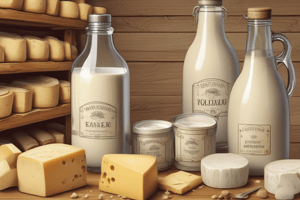Podcast
Questions and Answers
What is the first step in the cheese-making process?
What is the first step in the cheese-making process?
Milk Preparation
What causes the milk to separate into curds and whey during coagulation?
What causes the milk to separate into curds and whey during coagulation?
Adding a coagulant (such as rennet or vegetarian alternatives)
What is the purpose of cutting the curds into smaller pieces during curd formation?
What is the purpose of cutting the curds into smaller pieces during curd formation?
To release more whey
What is the liquid portion of milk called?
What is the liquid portion of milk called?
What is the final step in cheese production that allows flavors and textures to develop?
What is the final step in cheese production that allows flavors and textures to develop?
What are some common sources of milk used in cheese making?
What are some common sources of milk used in cheese making?
What are starter cultures in cheese production?
What are starter cultures in cheese production?
What is the role of coagulants in cheese production?
What is the role of coagulants in cheese production?
Why is salt considered a crucial ingredient in cheese production?
Why is salt considered a crucial ingredient in cheese production?
How do spices and flavorings contribute to cheese production?
How do spices and flavorings contribute to cheese production?
What is the purpose of additives in cheese production?
What is the purpose of additives in cheese production?
Name a popular cheese variety and describe its characteristics.
Name a popular cheese variety and describe its characteristics.
Flashcards are hidden until you start studying
Study Notes
Cheese Production: Exploring the Art of Cheese Making and Ingredients
Cheese, a staple in the diets of millions, is more than just a tasty ingredient. It's a culinary and cultural phenomenon, a result of centuries of experimentation and refinement. In this article, we'll dive into the fascinating world of cheese production, focusing on the cheese-making process and the essential ingredients that give these dairy delights their unique flavors and textures.
The Cheese-Making Process
The creation of cheese is a multifaceted journey, centered around the transformation of milk into a solid, flavorful product. The process typically involves four key stages:
-
Milk Preparation: The first step is to ensure that the milk, usually sourced from cows, goats, or sheep, is of high quality, free from contamination, and has the appropriate composition for cheese making.
-
Coagulation: This is when the milk's proteins, mainly casein, are made to clump together to form solid curds. This is achieved by adding a coagulant, such as rennet (an enzyme from animal stomachs) or vegetarian alternatives, which cause the milk to separate into curds and whey.
-
Curd Formation and Draining: The curds are formed and cut into smaller pieces to release more whey (the liquid portion of milk). The curds are then allowed to drain, either by pressing or by gravity.
-
Maturation: The final step involves aging and ripening the cheese, which allows the flavors and textures to develop. This process usually happens in a controlled environment, either at room temperature or in refrigerated conditions, depending on the specific cheese variety.
Cheese Ingredients
Beyond milk, cheese production relies on several essential ingredients that contribute to its unique characteristics.
-
Starter cultures: These microorganisms (mainly bacteria or yeast) are added to the milk to facilitate the fermentation process, which helps break down the lactose (milk sugar) and produces specific flavors and aromas.
-
Coagulants: These are enzymes that help break down the milk proteins, leading to a solid curd formation. Rennet, a common coagulant, is derived from animal stomachs, while vegetarian alternatives are also available.
-
Salt: A crucial ingredient for maintaining the integrity and preservation of cheese, salt helps to inhibit the growth of spoilage microorganisms. The amount and method of adding salt varies depending on the cheese variety.
-
Spices and flavorings: These are often added to enhance the taste and aroma of cheese. Some popular options include pepper, herbs, and garlic.
-
Additives: These are used to modify the texture, appearance, and shelf life of cheese. Examples include lipases, which break down fats to produce specific flavors, and preservatives, such as sodium nitrite, to extend shelf life.
The Variety of Cheeses
Cheese production is a vast and complex field, with countless variations. Some of the most popular cheese varieties include:
- Cheddar: A hard and crumbly cheese from England, known for its nutty flavor.
- Mozzarella: A soft and creamy cheese from Italy, commonly used in pizza.
- Feta: A crumbly and tangy cheese from Greece, often used in salads and appetizers.
- Brie: A soft and creamy French cheese, known for its smooth texture and mild flavor.
- Parmesan: A hard and granular cheese from Italy, with a sharp and nutty flavor.
Adding Flavor to Your Cheese Knowledge
The world of cheese is vast and ever-changing, with new and exciting varieties emerging all the time. By understanding the cheese-making process and the essential ingredients used, you can deepen your appreciation for these culinary wonders and expand your knowledge of this fascinating and delicious topic. Next time you enjoy a slice of cheese, you'll have a better understanding of the art, science, and history behind its creation.
Studying That Suits You
Use AI to generate personalized quizzes and flashcards to suit your learning preferences.




